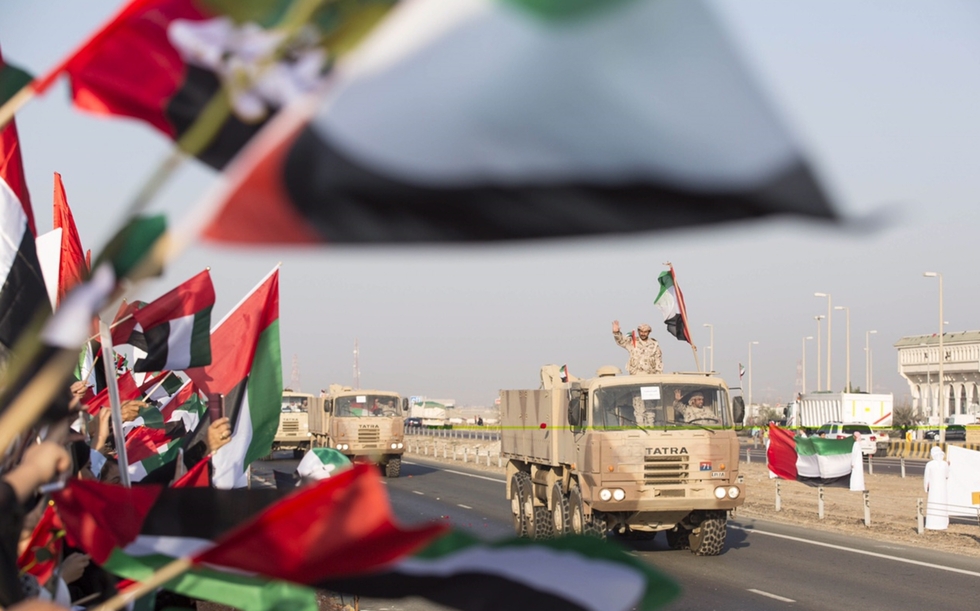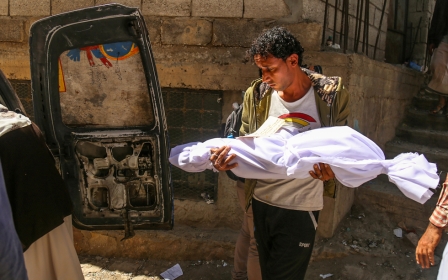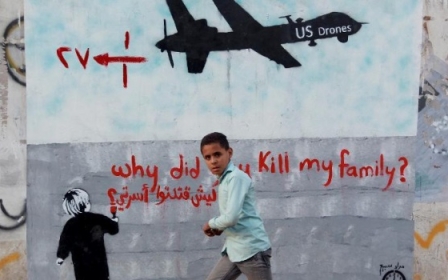What exactly is the UAE doing fighting a war in Yemen?

On 14 March, an Emirati fighter jet crashed into a mountainside near the southern port city of Aden. Both pilots were killed, bringing to 48 the number of Emiratis killed in action in the nearly year-long Yemen war.
The war began when the rebel Houthis, having already taken the capital Sanaa, pushed south and seized the southern port city of Aden against the advice of their Iranian backers. That was enough to bring both the Saudis and the Emiratis into action.
The Yemen war has been costly for the UAE. In September last year 45 Emirati soldiers were killed by a rocket launched by the Houthis. It was the worst day in the history of the country’s military.
The Saudis have paid much more heavily with their acknowledged losses standing at 300, though the real figure is believed to be very much higher, at least 3,000, a well-placed source told me. They have also suffered civilian losses as rockets fired from within Yemen rained down on the southern towns of Jizan and Najran.
Of course, it is the Yemenis who have paid by far the heaviest cost with many thousand killed and most of the country’s infrastructure destroyed.
But a war that began as a military adventure led by deputy crown prince and Defence Minister Mohammed bin Salman, the favoured son of King Salman, has at least some strategic significance for the Saudis.
A Yemen controlled by the rebel Houthis in coalition with the former president Ali Abdullah Saleh was a bridge too far. Saleh who ruled a united Yemen despotically for 32 years before being pushed out by the Saudis is a renegade in their eyes. And the thought that their regional foe Iran was poised to establish a foothold in the Arabian peninsula in a country the Saudis have always regarded as little more than a client state was something they simply could not abide.
But the Emiratis? Aside from loyalty to the Gulf Cooperation Council (GCC) it is hard to see why they entered the war. Until you begin to peel away the propaganda surrounding Operation Decisive Storm.
The UAE has longstanding commercial relations with Iran that have weathered the Iranian revolution, sanctions and Saudi opprobrium. They don’t see Iran as quite the bully boy that their next door neighbours do. Hence the rather more muted diplomatic downgrade - as opposed to the Saudis who shuttered their embassy in Tehran after it was sacked in January by protesters angry at the execution of the prominent Saudi Shia cleric Sheikh Nimr al-Nimr.
For a long time, too, the Emiratis have cast covetous eyes on Aden. They see it as a natural extension to the port facilities of Dubai, one that gives them easy access to the Indian Ocean and an alternative to the Strait of Hormuz which they and the other Gulf states share uneasily with Iran.
It was the Emiratis who led an amphibious assault on Aden in the summer of 2015, even after the Americans had rebuffed their request for US special forces troops to assist them. The assault succeeded, one of the few victories the Saudi coalition has thus far secured. It enabled the return of the current president Abd Rabbuh Mansur Hadi to Aden.
But since then there have been numerous lethal attacks on the city both by the Houthis and Saleh forces and by Daesh and al-Qaeda in the Arabian Peninsula (AQAP). Despite coalition claims that Aden was liberated, the neighbourhood is anything but safe and reportedly Emirati troops have been removed from frontline duty patrolling streets and the airport in a bid to minimise casualties.
Still Aden remains a prize worth acquiring.
Previously the huge DP World port container company, based in Dubai, had a deal with Aden and former president Saleh but pulled out in 2012 when his successor Hadi tried to renegotiate terms.
However in October last year DP World unveiled a plan to resuscitate the deal: “We are exploring areas where we can help our near neighbours in their initiatives to restore critical marine and trade infrastructure at Aden and look forward to developing our discussions in the immediate future,” was how Sultan bin Sulayem, chairman of DP World put it.
But before that can happen some sort of arrangement needs to be hammered out and the preferable one for the UAE would be a return to the old days - a Yemen divided in two as it was prior to 1990. The south, with Aden again restored to the status of a capital, would fall into the Emirati sphere. The north, once the Houthis and Saleh were sorted out, would be under Saudi sway.
However such an outcome remains highly unlikely, particularly given the strength of AQAP which has quietly taken control of the oil-rich southern province of Hadramawt town by town, in concert with local tribes. Daesh, as well, remains a persistent and potent threat and the Houthis and Saleh are not about to go quietly, nor agree to a partitioning of the country.
That leaves the Emiratis in a quandary. Like so many before them, they entered a war without an exit strategy. And as they count the cost they must be thinking about how and when to cut their losses.
- Bill Law is a Middle East analyst and a specialist in Gulf affairs. Follow him @BillLaw49.
The views expressed in this article belong to the author and do not necessarily reflect the editorial policy of Middle East Eye.
Photo: Emiratis welcoming a UAE military convoy as it travels from the Al-Hamra military base to Zayed city after returning from Yemen, on 7 November, 2015 (AFP/HO/WAM).
New MEE newsletter: Jerusalem Dispatch
Sign up to get the latest insights and analysis on Israel-Palestine, alongside Turkey Unpacked and other MEE newsletters
Middle East Eye delivers independent and unrivalled coverage and analysis of the Middle East, North Africa and beyond. To learn more about republishing this content and the associated fees, please fill out this form. More about MEE can be found here.





